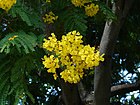Note: This is a project under development. The articles on this wiki are just being initiated and broadly incomplete. You can Help creating new pages.
Peltophorum pterocarpum
Peltophorum pterocarpum (commonly known as copperpod, yellow-flamboyant, yellow flametree, yellow poinciana or yellow-flame) is a species of Peltophorum, native to tropical southeastern Asia and a popular ornamental tree grown around the world.
Contents
- 1 Uses
- 2 Parts Used
- 3 Chemical Composition
- 4 Common names
- 5 Properties
- 6 Habit
- 7 Identification
- 8 List of Ayurvedic medicine in which the herb is used
- 9 Where to get the saplings
- 10 Mode of Propagation
- 11 How to plant/cultivate
- 12 Commonly seen growing in areas
- 13 Photo Gallery
- 14 References
- 15 External Links
Uses
Dysentery, Pains, Sores, Skin disorders, Muscular pain.
Parts Used
Chemical Composition
Chemical constituents such as aliphatic alcohols, fatty acids, amino acids, terpenoids, phenolics, flavonoids, alkaloids, steroids etc. [1]
Common names
| Language | Common name |
|---|---|
| Kannada | |
| Hindi | पीला गुलमोहर Peela gulmohar |
| Malayalam | |
| Tamil | |
| Telugu | |
| Marathi | NA |
| Gujarathi | NA |
| Punjabi | NA |
| Kashmiri | NA |
| Sanskrit | |
| English | Copperpod, Rusty shield-bearer |
Properties
Reference: Dravya - Substance, Rasa - Taste, Guna - Qualities, Veerya - Potency, Vipaka - Post-digesion effect, Karma - Pharmacological activity, Prabhava - Therepeutics.
Dravya
Rasa
Guna
Veerya
Vipaka
Karma
Prabhava
Habit
Identification
Leaf
| Kind | Shape | Feature |
|---|---|---|
| Bipinnate | linear in outline | 30–60 cm long, with 16–20 pinnae, each pinna with 20–40 oval leaflets 8–25 mm long and 4–10 mm broad. |
Flower
| Type | Size | Color and composition | Stamen | More information |
|---|---|---|---|---|
| Bisexual | Yellow | 2.5–4 cm diameter, produced in large compound raceme up to 20 cm long. Pollens are approximately 50 microns in size. |
Fruit
| Type | Size | Mass | Appearance | Seeds | More information |
|---|---|---|---|---|---|
| Simple Fruit | ovoid | 5–10 cm long and 2.5 cm broad | Red at first, Ripening black | {{{6}}} |
Other features
List of Ayurvedic medicine in which the herb is used
Where to get the saplings
Mode of Propagation
How to plant/cultivate
A plant of the moist to wet tropics, where it is usually found at elevations below 100 metres but can occasionally be found up to 1,600 metres. It grows best in areas where annual daytime temperatures are within the range 27 - 36°c, but can tolerate 10 - 40°c. Plants have been known to survive occasional low temperatures down to -5°c. It prefers a mean annual rainfall in the range 1,200 - 1,800mm, but tolerates 1,000 - 4,000mm. It thrives best under more or less seasonal conditions with a dry season of 1 - 3 months. [3]
Commonly seen growing in areas
Grassland fields, Teak forests.
Photo Gallery
References
External Links
- Ayurvedic Herbs known to be helpful to treat Dysentery
- Ayurvedic Herbs known to be helpful to treat Pains
- Ayurvedic Herbs known to be helpful to treat Sores
- Ayurvedic Herbs known to be helpful to treat Skin disorders
- Ayurvedic Herbs known to be helpful to treat Muscular pain
- Herbs with Stem used in medicine
- Herbs with Leaves used in medicine
- Herbs with Fruits used in medicine
- Herbs with common name in Hindi
- Herbs with common name in English
- Habit - Tree
- Index of Plants which can be propagated by Seeds
- Herbs that are commonly seen in the region of Grassland fields
- Herbs that are commonly seen in the region of Teak forests
- Herbs
- Fabaceae



